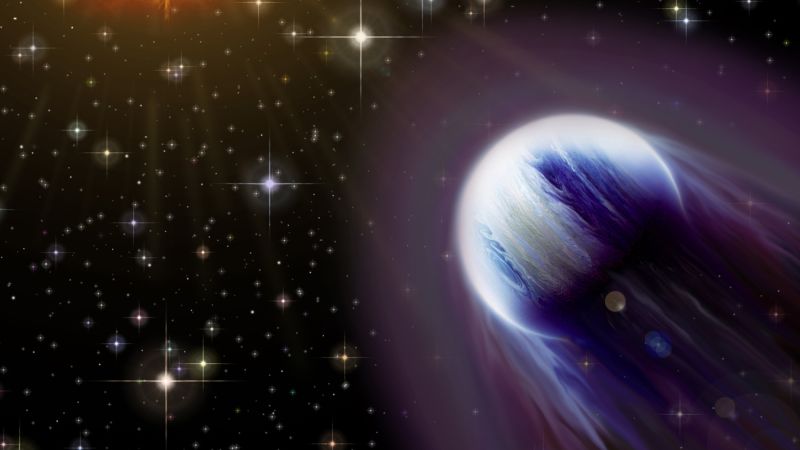
Gaia 3 veri yayınından çıkan şaşırtıcı bir keşif, Gaia’nın yıldızların şeklini değiştiren yıldız depremlerini – bir yıldızın yüzeyindeki küçük hareketleri – tespit edebildiğidir; bu, gözlemevinin başlangıçta inşa edilmemiş olduğu bir şeydir. Kredi: ESA/Gaia/DPAC, CC BY-SA 3.0 IGO
Gaia, Avrupa Uzay Ajansı’nın (ESA) bir milyardan fazla yıldızın doğru bir 3D haritasını oluşturma görevidir.[{” attribute=””>Milky Way galaxy and beyond. Although it launched all the way back in 2013, it is still working to accurately map the the motions, luminosity, temperature and composition of the stars in our galaxy.
Along the way it has made numerous discoveries, such as detecting a shake in the Milky Way, the observation of almost 500 explosions in galaxy cores, crystallization in white dwarfs, and discovering a billion-year-old river of stars. It also revealed the total weight of the Milky Way, a direct measurement of the galactic bar in the Milky Way, mysterious fossil spiral arms in the Milky Way, and a new member of the Milky Way family.
Today marks the data of the third data release from Gaia. The first data release was on September 14, 2016, followed by the second data release on April 25, 2018. On December 3, 2020, they did an early third data release with detailed data on more than 1.8 billion stars. All this data is helping to reveal the origin, structure, and evolutionary history of our galaxy.

This image shows four sky maps made with the new ESA Gaia data released on June 13, 2022. Credit: © ESA/Gaia/DPAC; CC BY-SA 3.0 IGO
Today (June 13, 2022), ESA’s Gaia mission releases its new treasure trove of data about our home galaxy. Astronomers describe strange ‘starquakes’, stellar DNA, asymmetric motions, and other fascinating insights in this most detailed Milky Way survey to date.
Gaia is ESA’s mission to create the most accurate and complete multi-dimensional map of the Milky Way. This allows astronomers to reconstruct our home galaxy’s structure and past evolution over billions of years, and to better understand the lifecycle of stars and our place in the Universe.
Veri sürümü 3’teki yenilikler neler?
Gaia 3 veri sürümü, galaksimizdeki yaklaşık iki milyar yıldızın yeni ve geliştirilmiş ayrıntılarını içerir. Katalog, aşağıdakiler dahil olmak üzere yeni bilgiler içerir: kimyasal bileşimleryıldız sıcaklıkları, renkleri, kütleleri, yaşları ve yıldızların bize doğru veya bizden uzaklaşma hızları (radyal hız). Bu bilgilerin çoğu, yeni yayınlanan spektroskopi Veri, yıldız ışığının bileşen renklerine (gökkuşağı gibi) bölündüğü bir teknoloji. Veriler ayrıca, zaman içinde parlaklığı değiştirenler gibi özel yıldız alt kümelerini de içerir.
Bu veri setinde ayrıca bugüne kadarki en büyük ikili yıldız kataloğu, asteroitler ve gezegen uyduları gibi binlerce Güneş Sistemi nesnesi ve Samanyolu’nun dışındaki milyonlarca galaksi ve kuasar yer alıyor.
depremler
Yeni verilerden ortaya çıkan en şaşırtıcı keşiflerden biri, Gaia’nın yıldızların şekillerini değiştiren yıldız depremlerini – bir yıldızın yüzeyindeki küçük hareketleri – tespit edebildiğidir; bu, gözlemevinin başlangıçta inşa edilmediği bir şeydi.
Daha önce Gaia, yıldızların küresel şeklini korurken periyodik olarak şişmesine ve büzülmesine neden olan radyal salınımlar bulmuştu. Ancak Gaya şimdi büyük ölçekli bir tsunamiye çok benzeyen başka titreşimler de tespit etti. Bu radyal olmayan salınımlar, yıldızın küresel şeklini değiştirir ve bu nedenle tespit edilmesi zordur.
Gaia, binlerce yıldızda radyal olmayan güçlü depremler buldu. Gaia, yıldızlarda daha önce nadiren görülen bu tür titreşimleri de tespit etti. Bu yıldızların mevcut teoriye göre herhangi bir deprem olmaması gerekirken, Gaia onları yüzeylerinde tespit etti.
Gaya Collaboration’ın bir üyesi olan Belçika’daki KU Leuven’den Connie Aerts, “Yıldız depremleri bize yıldızlar, özellikle de iç işleyişleri hakkında çok şey öğretiyor. Gaia, devasa yıldız bilimi için bir altın madeni açıyor” diyor.
yıldız DNA’sı
Yıldızların yapıldığı malzeme bize nerede doğduklarını ve bir sonraki yolculuklarını ve dolayısıyla Samanyolu’nun tarihini anlatabilir. Bugün verilerin yayınlanmasıyla birlikte Gaia, güneş komşularımızdan etrafımızdaki daha küçük galaksilere kadar 3 boyutlu hareketlerle birleştirilmiş galaksinin en büyük kimyasal haritasını ortaya koyuyor.
Bazı yıldızlar diğerlerinden daha fazla “ağır metal” içerir. sırasında[{” attribute=””>Big Bang, only light elements were formed (hydrogen and helium). All other heavier elements – called metals by astronomers – are built inside stars. When stars die, they release these metals into the gas and dust between the stars called the interstellar medium, out of which new stars form. Active star formation and death will lead to an environment that is richer in metals. Therefore, a star’s chemical composition is a bit like its DNA, giving us crucial information about its origin.

This image shows an artistic impression of the Milky Way, and on top of that an overlay showing the location and densities of a young star sample from Gaia’s data release 3 (in yellow-green). The “you are here” sign points towards the Sun. Credit: © ESA/Gaia/DPAC; CC BY-SA 3.0 IGO
With Gaia, we see that some stars in our galaxy are made of primordial material, while others like our Sun are made of matter enriched by previous generations of stars. Stars that are closer to the center and plane of our galaxy are richer in metals than stars at larger distances. Gaia also identified stars that originally came from different galaxies than our own, based on their chemical composition.
“Our galaxy is a beautiful melting pot of stars,” says Alejandra Recio-Blanco of the Observatoire de la Côte d’Azur in France, who is a member of the Gaia collaboration.
“This diversity is extremely important, because it tells us the story of our galaxy’s formation. It reveals the processes of migration within our galaxy and accretion from external galaxies. It also clearly shows that our Sun, and we, all belong to an ever-changing system, formed thanks to the assembly of stars and gas of different origins.”

This image shows the orbits of the more than 150,000 asteroids in Gaia’s data release 3, from the inner parts of the Solar System to the Trojan asteroids at the distance of Jupiter, with different color codes. The yellow circle at the center represents the Sun. Blue represents the inner part of the Solar System, where the Near Earth Asteroids, Mars crossers, and terrestrial planets are. The Main Belt, between Mars and Jupiter, is green. Jupiter trojans are red. Credit: © ESA/Gaia/DPAC; CC BY-SA 3.0 IGO, Acknowledgements: P. Tanga (Observatoire de la Côte d’Azur)
Binary stars, asteroids, quasars, and more
Other papers that are published today reflect the breadth and depth of Gaia’s discovery potential. A new binary star catalog presents the mass and evolution of more than 800 thousand binary systems, while a new asteroid survey comprising 156 thousand rocky bodies is digging deeper into the origin of our Solar System. Gaia is also revealing information about 10 million variable stars, mysterious macro-molecules between stars, as well as quasars and galaxies beyond our own cosmic neighborhood.

The position of each asteroid at 12:00 CEST on June 13, 2022, is plotted. Each asteroid is a segment representing its motion over 10 days. Inner bodies move faster around the Sun (yellow circle at the center). Blue represents the inner part of the Solar System, where the Near Earth Asteroids, Mars crossers, and terrestrial planets are. The Main Belt, between Mars and Jupiter, is green. The two orange ‘clouds’ correspond to the Trojan asteroids of Jupiter. Credit: © ESA/Gaia/DPAC; CC BY-SA 3.0 IGO, Acknowledgements: P. Tanga (Observatoire de la Côte d’Azur)
“Unlike other missions that target specific objects, Gaia is a survey mission. This means that while surveying the entire sky with billions of stars multiple times, Gaia is bound to make discoveries that other more dedicated missions would miss. This is one of its strengths, and we can’t wait for the astronomy community to dive into our new data to find out even more about our galaxy and its surroundings than we could’ve imagined,” says Timo Prusti, Project Scientist for Gaia at ESA.

“Analist. Tutkulu zombi gurusu. Twitter uygulayıcısı. İnternet fanatiği. Dost pastırma hayranı.”



More Stories
Çalışma, dev uzaylı gezegenin kabarık pamuk şekeri yoğunluğuna sahip olduğunu ortaya koyuyor
Avrupa, iddialı Merkür sondasının gezegene ulaşıp ulaşamayacağından emin değil
Webb, antik evrende rekor kıran bir kara delik birleşmesini keşfetti